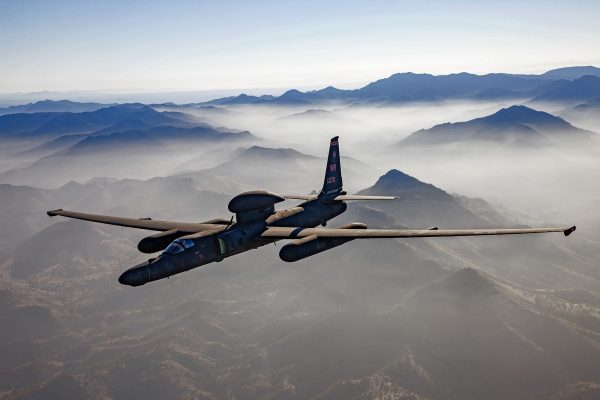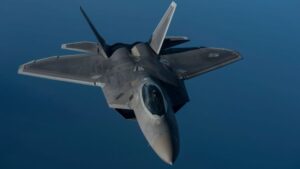This article first appeared on Warrior Maven, a Military Content Group member website. (Washington D.C.) Imagine a scenario where a U-2 spy plane were flying at unparalleled high altitudes and, as part of its mission, wound up spotting a group of enemy fighter jets or even a mechanized armored vehicle ground column. Just how fast could that spy plane get targeting information to fifth-generation fighter jets or ground commanders in position to attack? In this kind of circumstance, target coordinates, mapping, speed and anticipated time of impending attack data would need to be immediately sent to F-22 or F-35 stealth jet fighters, ground-based air defense locations and even advancing infantry formations.
An emerging Lockheed Martin Skunk Works program called Project Hydra demonstrated this kind of air-to-air and air-to-ground connectivity in an exercise with the Air Force and Missile Defense Agency a year ago. The experiment, according to a statement from Lockheed’s well-known and historically secretive Skunk Works division, “successfully linked a U-2, five F-35s, and an F-22 in the air and provided real-time 5th Generation data to operators on the ground.”
The concept and potential breakthrough here is as clear as it is simple: it is about the speed of attack.
This central question, which is one of timing, could easily be identified as one of the defining elements of contemporary military modernization strategic thinking, essentially massively shortening or truncating sensor-to-shooter time to get ahead of or inside of an enemy’s decision cycle. This idea is often put in the context of the decades-old, yet still defining idea from former Air Force office John Boyd’s Observe, Orient, Decide, Act (OODA) Loop concept. Today, advanced networking technology with datalinks, high bandwidth waveforms, AI-empowered computing and software programmable radio is progressing at unprecedented speeds. Often referred to by senior U.S. military leaders as operating at the “speed of relevance,” the concept of multi-domain, real-time combat platform connectivity able to instantly pair “sensors” to “shooters” could well be described as a number one Pentagon priority. It is the backbone of the now progressing Joint All Domain Command and Control (JADC2) effort.
“Project Hydra marks the first time that bi-directional communications were established between 5th Generation aircraft in-flight while also sharing operational and sensor data down to ground operators for real-time capability,” Jeff Babione, vice president and general manager of Lockheed Martin Skunk Works, said in a company statement to Warrior several years ago.
Technically, the synergy was brought to fruition in large measure through a special Open Systems Gateway payload aboard a U-2 spy plane, which managed to integrate previously disparate communications pathways such as the F-35 jet’s Multifunction Advanced Datalink and F-22 jet’s Intra-Flight Data Link. The Air Force has in recent years made great progressing improving F-22-to-F-35 fighter connectivity in war through the use of a two-way-enabled LINK 16 connection and secure, less jammable radio linkages. However, Project Hydra appears to extend this to yet a new level by virtue of expanding secure pathways of connectivity and linking vital assets such as the U-2 in real-time. “Target tracks were transmitted by and through the U-2 into the fighter avionics and pilot displays,” the Skunk Works statement declared.
When a U-2 spy plane can pass target details to an F-22 fighter jet, an F-35 fighter jet, and ground control center all at once, in near real-time, amid heavy multi-domain combat, the speed and operational efficiency of warfare attack change dramatically.
Achieving this kind of “warfare at speed” was the intent, and the apparent result of a recent test conducted by the Missile Defense Agency and Air Force with Lockheed Martin’s Skunk Works division. Operating at high altitudes, a U-2 spy plane sent data concurrently to five F-35 jets, one F-22 jet, and a ground control station concurrently using a specially configured “gateway” payload built into the U-2 Dragon Lady. The test, which is reported to have yielded promising results, was part of Skunk Works’ ongoing Project Hydra program.
This article first appeared on Warrior Maven, a Military Content Group member website. (Washington D.C.) Imagine a scenario where a U-2 spy plane were flying at unparalleled high altitudes and, as part of its mission, wound up spotting a group of enemy fighter jets or even a mechanized armored vehicle ground column. Just how fast could that spy plane get targeting information to fifth-generation fighter jets or ground commanders in position to attack? In this kind of circumstance, target coordinates, mapping, speed and anticipated time of impending attack data would need to be immediately sent to F-22 or F-35 stealth jet fighters, ground-based air defense locations and even advancing infantry formations.
An emerging Lockheed Martin Skunk Works program called Project Hydra demonstrated this kind of air-to-air and air-to-ground connectivity in an exercise with the Air Force and Missile Defense Agency a year ago. The experiment, according to a statement from Lockheed’s well-known and historically secretive Skunk Works division, “successfully linked a U-2, five F-35s, and an F-22 in the air and provided real-time 5th Generation data to operators on the ground.”
The concept and potential breakthrough here is as clear as it is simple: it is about the speed of attack.
This central question, which is one of timing, could easily be identified as one of the defining elements of contemporary military modernization strategic thinking, essentially massively shortening or truncating sensor-to-shooter time to get ahead of or inside of an enemy’s decision cycle. This idea is often put in the context of the decades-old, yet still defining idea from former Air Force office John Boyd’s Observe, Orient, Decide, Act (OODA) Loop concept. Today, advanced networking technology with datalinks, high bandwidth waveforms, AI-empowered computing and software programmable radio is progressing at unprecedented speeds. Often referred to by senior U.S. military leaders as operating at the “speed of relevance,” the concept of multi-domain, real-time combat platform connectivity able to instantly pair “sensors” to “shooters” could well be described as a number one Pentagon priority. It is the backbone of the now progressing Joint All Domain Command and Control (JADC2) effort.
“Project Hydra marks the first time that bi-directional communications were established between 5th Generation aircraft in-flight while also sharing operational and sensor data down to ground operators for real-time capability,” Jeff Babione, vice president and general manager of Lockheed Martin Skunk Works, said in a company statement to Warrior several years ago.
Technically, the synergy was brought to fruition in large measure through a special Open Systems Gateway payload aboard a U-2 spy plane, which managed to integrate previously disparate communications pathways such as the F-35 jet’s Multifunction Advanced Datalink and F-22 jet’s Intra-Flight Data Link. The Air Force has in recent years made great progressing improving F-22-to-F-35 fighter connectivity in war through the use of a two-way-enabled LINK 16 connection and secure, less jammable radio linkages. However, Project Hydra appears to extend this to yet a new level by virtue of expanding secure pathways of connectivity and linking vital assets such as the U-2 in real-time. “Target tracks were transmitted by and through the U-2 into the fighter avionics and pilot displays,” the Skunk Works statement declared.
When a U-2 spy plane can pass target details to an F-22 fighter jet, an F-35 fighter jet, and ground control center all at once, in near real-time, amid heavy multi-domain combat, the speed and operational efficiency of warfare attack change dramatically.
Achieving this kind of “warfare at speed” was the intent, and the apparent result of a recent test conducted by the Missile Defense Agency and Air Force with Lockheed Martin’s Skunk Works division. Operating at high altitudes, a U-2 spy plane sent data concurrently to five F-35 jets, one F-22 jet, and a ground control station concurrently using a specially configured “gateway” payload built into the U-2 Dragon Lady. The test, which is reported to have yielded promising results, was part of Skunk Works’ ongoing Project Hydra program.
While the impact of this kind of expedited attack possibility is both defining and clear in many respects, some of the technical nuances which bring this to fruition are a bit more nuanced and complex. The U-2 payload, called the Open System Gateway, is engineered with technical infrastructure sufficient to enable connectivity between otherwise disparate communications systems such as the F-22 jet’s Intra-Flight Data Link, F-35 jet’s Multifunction Advanced Datalink, Link-16, and a datalink called Tactical Targeting Network Terminal.
“The Project Hydra effort also marked the first time F-35 sensor data was delivered to an operational ground system over a Tactical Targeting Network Terminal (TTNT) link using an airborne gateway,” according to a Skunk Works statement on the test. The demonstration connected a Common Missile Control Center with the Shadow Operations Center at Nellis Air Force Base to view the sensor data for “operational command and control of highly capable air assets,” according to the statement.
One of the communications avenues made possible through this kind of technical infrastructure gateway is secure two-way connectivity between F-35 jets and F-22 jets which preserves stealth mode. This means it is less hackable and emits a much less detectable electronic signature. Northrop Grumman is now testing what developers called a “radio translator” engineered to connect an F-22 datalink Interflight Datalink with the F-35’s datalink Multi-Function Advanced Datalink.
Stealth mode is preserved by a Northrop Grumman anti-jam integrated software-defined radio device called Freedom 550. Software programmable radio works by sending IP packets of data through waveforms to transmit combat-relevant information. Several years ago, Northrop Grumman weapons developers explained that there can be one multi-function box that does as many as twenty-five different functions. Stealth mode is sustained, by using a smaller number of modules to connect the two data links together through a converter. Fewer modules help preserve stealthy communications by virtue of decreasing the emissions of an omnidirectional antenna, which is more detectable. The broader the signal and the wider the emission, the larger the electronic signature, something which can of course present a risk of being detected.



